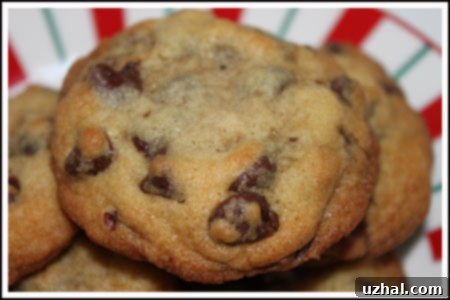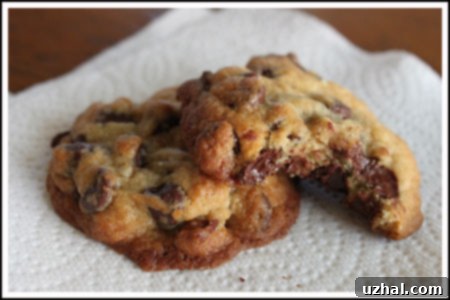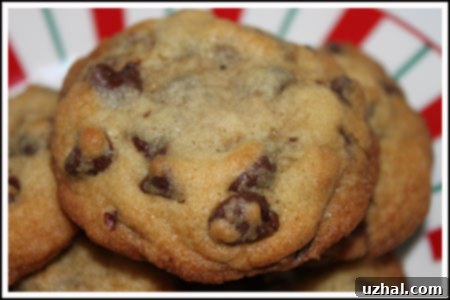W. Richard Stevens’ Ultimate Chocolate Chip Cookies: The Science Behind the Perfect Bake
In the vast world of baking, countless recipes lay claim to the title of “Ultimate Chocolate Chip Cookies.” However, this particular rendition stands out, not just for its exceptional results, but for its unique lineage and scientific foundation. This isn’t just any cookie recipe; it’s a culinary masterpiece with a fascinating backstory, deeply rooted in precision and an understanding of the science of baking.
The journey of this esteemed recipe begins with Cooking for Engineers, a blog known for dissecting recipes with a scientific lens. The blog’s founder, Michael, an old neighbor of ours, has dedicated years to exploring the intricate chemistry of cooking, always providing enlightening insights. What makes this recipe even more intriguing is that it didn’t originate directly from Michael, but was passionately recommended by a reader who attributed it to none other than W. Richard Stevens. For those unfamiliar, Stevens was a highly respected Unix expert and the author of numerous seminal books on the subject – an unexpected yet brilliant source for a dessert classic.
Stevens’ meticulous approach to his professional life evidently extended to his kitchen. He didn’t just follow a recipe; he refined it, drawing inspiration from renowned culinary figures and applying principles that elevate a simple cookie to an extraordinary treat. This recipe promises not just a cookie, but an experience – a perfectly textured, deeply flavored, and truly “ultimate” chocolate chip cookie that reflects careful thought and scientific understanding.

Flo Braker’s Creaming Method: A Foundation of Excellence
At the heart of W. Richard Stevens’ Ultimate Chocolate Chip Cookies lies a technique championed by the esteemed baker Flo Braker: her distinctive creaming method. Stevens, a declared fan of Braker, integrated her precise approach to butter and sugar into his recipe, a move that significantly contributes to the cookies’ superior texture and rise. This method, while seemingly subtle, harnesses crucial scientific principles to achieve baking perfection.
The Magic of Cold Butter
Unlike many traditional recipes that call for room-temperature butter, Braker’s method, adopted by Stevens, begins with cold butter. In the past, this was a somewhat unconventional step for chocolate chip cookies, but its benefits are now widely recognized among expert bakers. When cold butter is beaten with sugar, its firm structure allows for more air to be incorporated into the mixture. These tiny air pockets, when heated in the oven, expand, creating a lighter, more tender crumb and preventing the cookies from spreading too thinly. The friction generated during creaming also helps to slightly warm the butter, creating an ideal emulsion with the sugars.
Slow, Incremental Egg Addition
Another hallmark of Flo Braker’s method is the careful incorporation of eggs. Instead of adding eggs all at once, they are beaten separately and then introduced to the creamed butter and sugar mixture gradually, in small increments, over a period of approximately 3 minutes. This slow addition is crucial for creating a stable emulsion. Adding eggs too quickly can cause the mixture to “break,” separating the fats from the liquids. By integrating them slowly, the mixture remains cohesive and smooth, leading to a more consistent dough and ultimately, a more uniform cookie texture. This controlled process ensures that the fat and liquid components are perfectly bound, resulting in a richer, more emulsified dough.
The Crucial Role of Chilling Cookie Dough Overnight
W. Richard Stevens was an early and fervent advocate for chilling cookie dough, a practice he considered non-negotiable for achieving truly “ultimate” chocolate chip cookies. He stressed that without this overnight chilling period, the cookies would be merely “regular chocolate chip cookies.” Today, the benefits of chilling dough are widely understood and embraced by home bakers and professionals alike, but Stevens was at the forefront of emphasizing this essential step in his recipe.
Science of Dough Chilling: Flavor, Texture, and Spread
Chilling cookie dough for an extended period, typically overnight or for at least 6 hours, significantly enhances several aspects of the final product:
- Flavor Development: Time allows the dry ingredients, especially the flour, to fully hydrate. This hydration process helps the flavors to meld and deepen. The sugars in the dough also have more time to fully dissolve, leading to a more complex and nuanced flavor profile. Essentially, the dough “matures,” resulting in a richer, more pronounced cookie flavor.
- Improved Texture: Cold butter maintains its solid state longer in the oven. This means the cookies spread less, allowing them to bake up thicker with a chewier center and slightly crisper edges. The chilled dough also provides a more tender crumb structure because the gluten in the flour has more time to relax.
- Reduced Spread: When the butter in the dough is cold, it takes longer to melt in the hot oven. This slower melting process allows the cookie structure to set before the butter fully liquifies, preventing the cookies from spreading too thin and flat. Instead, they hold their shape better, resulting in those desirable thick, soft-centered cookies.
- Ease of Handling: Chilled dough is firmer and less sticky, making it much easier to scoop, shape, and handle without it sticking to your hands or utensils.
Stevens’ insistence on this step was truly ahead of its time, demonstrating his deep understanding that great baking is often about patience and technique as much as it is about ingredients. It’s this combination of Flo Braker’s meticulous creaming method and Stevens’ emphasis on chilling that elevates these cookies from good to genuinely ultimate.

I wholeheartedly recommend following the original recipe to experience the magic firsthand. However, in the event that the original link becomes unavailable or if you prefer a measured approach, I’ve provided my adapted version below. My adaptation slightly increases the salt content by a pinch, which I find balances the sweetness and enhances the chocolate flavor beautifully.
Before diving into the full recipe, a quick note on ingredients: while the method is key, quality ingredients make a significant difference. Opt for good quality unsalted butter and consider your choice of chocolate chips. Brands like Guittard, as suggested in the recipe, offer superior flavor and melt beautifully, contributing to that rich, gooey chocolate experience.
Recipe: W. Richard Stevens’ Ultimate Chocolate Chip Cookies

Santa’s New Favorite Chocolate Chip Cookie Recipe
Anna
Pin Recipe
Ingredients
- 2 ½ cups unbleached all purpose flour (315 grams)
- 1 ¼ tsp. baking soda
- 1 ⅛ teaspoon of salt use ½ teaspoon if using salted butter
- 8 oz unsalted butter (230 grams)
- 1 cup very firmly packed light brown sugar (200 grams)
- ¾ cup granulated sugar (150 grams)
- 2 large eggs
- 1 ½ teaspoons vanilla extract
- 2 cups toasted pecans or walnuts chopped
- 3 cups chocolate chips (Guittard) 18 oz — Use only 2 cups if desired
Instructions
-
Sift together the flour, baking soda, and salt into a bowl; set aside. This ensures an even distribution of leavening agents and eliminates lumps.
-
In the bowl of a stand mixer fitted with the paddle attachment, beat the cold butter on medium speed until it becomes creamy and light, usually for 1-2 minutes. Then, add both the brown and granulated sugars. Continue beating at medium speed for about 3 to 4 minutes. Remember to stop and scrape down the sides and bottom of the bowl occasionally to ensure all ingredients are thoroughly combined and evenly creamed. This step is critical for incorporating air.
-
While the butter and sugar are creaming, whisk the eggs and vanilla extract together in a separate small bowl or measuring cup. With the mixer still in motion at medium-low speed, slowly add the egg mixture to the creamed butter and sugar, one tablespoon at a time. This gradual addition, taking another 4 minutes, is key to maintaining a stable emulsion and preventing the mixture from curdling. The goal is a smooth, homogenous mixture.
-
Reduce the mixer speed to its lowest setting, or mix by hand, and gradually add the sifted dry ingredients. Mix only until just incorporated to avoid overmixing, which can lead to tough cookies. Once the dry ingredients are combined, add the chocolate chips and nuts (if using) and stir briefly until evenly distributed throughout the dough.
-
Shape the dough into golf ball-sized portions. Arrange these dough balls closely together on a cookie sheet, as they are not being baked yet, but chilled. Cover the cookie sheet with plastic wrap and chill the dough overnight, or for a minimum of 6 hours. This extended chill time is essential for flavor development and achieving the desired texture. After chilling, remove the dough balls and allow them to warm up slightly to room temperature for about 30 minutes. Arrange the warmed dough balls on ungreased cookie sheets, spacing them about 3 inches apart. Gently flatten each dough ball to resemble a hockey puck, roughly ¾-inch high, ensuring the edges remain straight up and down. Make a slight depression in the center of each with your finger – this helps create that signature thick, chewy center.
-
Preheat your oven to 400 degrees Fahrenheit (200°C). Bake the cookies for 8-10 minutes. Baking times can vary, so keep a close eye on them; mine often take a little longer. The edges should be a golden brown, but the center 1-inch of the cookie should still appear pale and slightly underdone. This ensures a chewy interior. Once baked, allow the cookies to cool on the baking pan for 5 minutes before transferring them to a wire rack to cool completely. This resting period allows them to set without breaking.
-
This recipe typically yields about 32 cookies when using all the specified chocolate chips and nuts. If you opt for only 2 cups of chocolate chips and omit the nuts, you can expect to get around 28 cookies.
Notes
Why These Cookies Are Truly Ultimate
The “ultimate” designation for these chocolate chip cookies is well-earned, stemming from the thoughtful application of advanced baking techniques. The combination of Flo Braker’s creaming method, with its emphasis on cold butter and gradual egg incorporation, and W. Richard Stevens’ steadfast advocacy for overnight dough chilling, results in a cookie that is far from ordinary. These techniques work synergistically to create a cookie with a perfect balance of textures: a delightful crispness at the edges, giving way to a wonderfully chewy and thick center, studded with rich, melted chocolate. The deep, complex flavors that develop during the chilling process further elevate this recipe, making each bite a truly satisfying experience.
Beyond the technical brilliance, there’s a certain charm in knowing this recipe was championed by a Unix expert. It speaks to the universal appeal of good food and the joy of mastering a craft, whether it’s coding or baking. So, whether you’re a seasoned baker or just starting, we encourage you to embark on this culinary adventure. The extra steps and patience are undoubtedly worth it for a batch of cookies that truly lives up to its “ultimate” name.
Explore More Delicious Recipes from Cookie Madness
If you’ve enjoyed perfecting these Ultimate Chocolate Chip Cookies, you might be interested in exploring other delightful recipes. Here are some related links from Cookie Madness:
- Double Chocolate Chip Bread
- Blackberry Yogurt Loaf
- Richard Sax’s Whipped Cream Pound Cake
- Richard Sax Butterscotch Brownies from Classic Home Desserts
- Ultimate Yellow Cupcakes